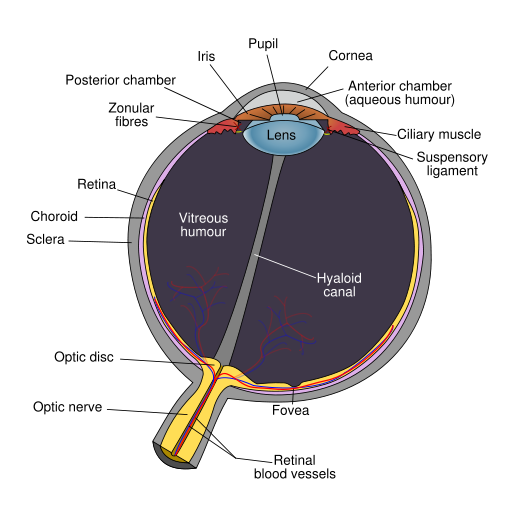Optic disc
Editor-In-Chief: C. Michael Gibson, M.S., M.D. [1]
The optic disc or optic nerve head is the location where ganglion cell axons exit the eye to form the optic nerve. There are no light sensitive rods or cones to respond to a light stimulus at this point thus it is also known as "the blind spot" or "anatomical blind spot"; the break in the visual field created by the optic disc is also called "the blind spot" or "physiological blind spot". The optic nerve head in a normal human eye carries from 1 to 1.2 million neurons from the eye towards the brain.
Clinical examination
The eye is unique due to the transparency of its optical medium. Almost all eye structures can be examined with appropriate optical equipment and lenses. Using a modern direct ophthalmoscope gives a view of the optic disc using the principle of reversibility of light. A slit lamp biomicroscopic examination along with an appropriate aspheric focusing lens (+66D, +78D or +90D) is required for a detailed stereoscopic view of the optic disc and structures inside the eye. Inspection of the optic disc by ophthalmoscopy or biomicroscopy can give an indication of the health of the optic nerve. In particular, the eye care physician notes the colour, cupping size (as a cup-to-disc ratio), sharpness of edge, swelling, hemorrhages, notching in the optic disc and any other unusual anomalies. It is useful for finding evidence corroborating the diagnosis of glaucoma and other optic neuropathies, optic neuritis, anterior ischemic optic neuropathy or papilledema (i.e. optic disc swelling produced by raised intracranial pressure). Women in advanced stage of pregnancy with pre-eclampsia should be screened by an ophthalmoscopic examination of the optic disc for early evidence of rise in intracranial pressure.

Imaging of the optic disc
Traditional colour-film camera images are the gold standard in imaging, requiring an expert ophthalmic photographer, ophthalmic technician, optometrist or an ophthalmologist for taking standardised pictures of the optic disc. Stereoscopic images offer an excellent investigative tool for serial follow-up of suspected changes in the hands of an expert optometrist or ophthalmologist. However, since not everybody can be trained so well, automated techniques have been devised to supplant or replace the human expertise. Heidelberg Retinal Tomography (HRT-II), GDx-VCC and optical coherence tomography (Stratus-OCT 3) are the currently available computerised techniques for imaging various structures of the eyes, including the optic disc. They quantitate the nerve fiber layer of disc and surrounding retina and statistically correlate the findings with a database of previously screened population of normals. They are useful for baseline and serial follow-up to monitor minute changes in optic disc morphology. It should be noted that imaging won't provide conclusive evidence for clinical diagnosis however, and the evidence needs to be supplanted by serial physiological testing for functional changes. Such tests may include visual field charting, and final clinical interpretation of the complete eye examination by an eye care physician. Ophthalmologists and Optometrists are able to provide this service.

External links
de:Blinder Fleck (Auge) nl:Blinde vlek no:Den blinde flekk sk:Slepá škvrna (oko) sv:Blinda fläcken